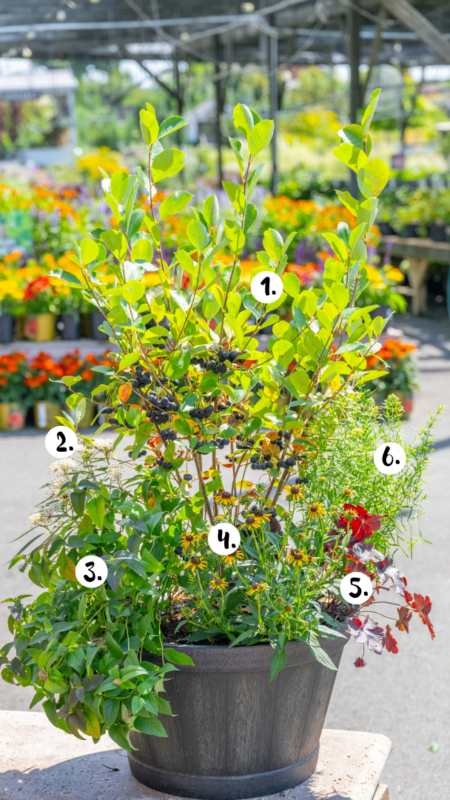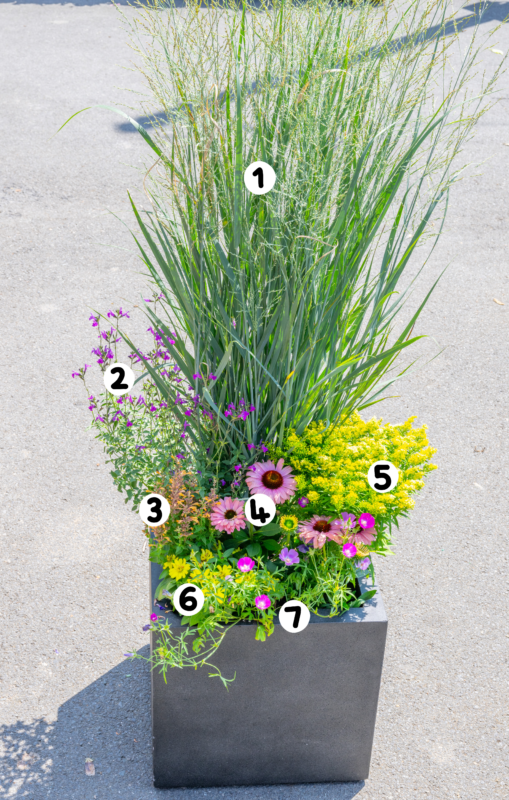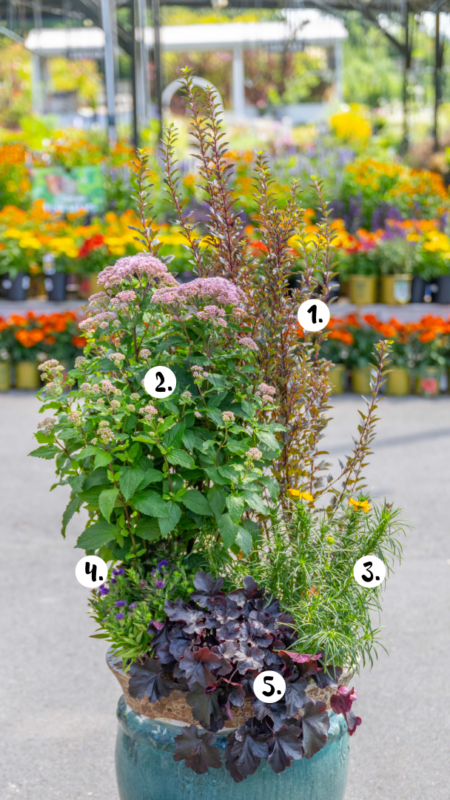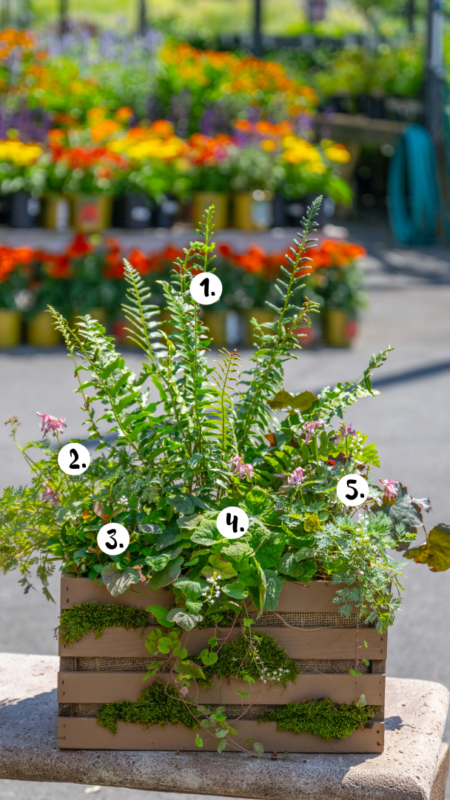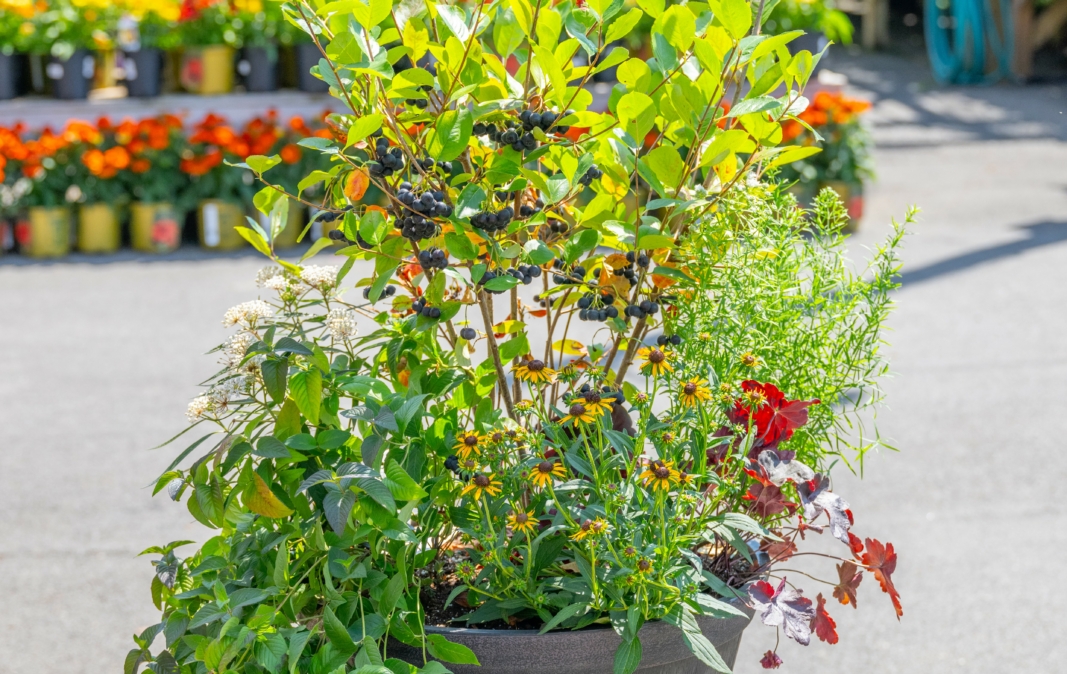
Native Fall Container Designs
Planting native plants in container gardens will invite local pollinators, birds and beneficial insects to your patio, porch, balcony or front stoop. When planted in the landscape, native plants have many benefits, such as helping with erosion control and filtering rainwater. In containers, they provide beauty, texture and the opportunity to supply nectar and food sources to pollinators and local birds. In our mid-Atlantic region, native plants provide seeds and berries for birds and 96% of those birds feed their young spawn with caterpillars which are often found only on native plants. Here are some of our North American native plant picks that thrive in containers–several are local to our Northern Virginia area.
Whiskey Barrel of Berries
Looks best with 6 hours of morning sun and moist, well-draining soil.
1. Black chokeberry – Aronia melanocarpa
Chokeberry produces beautiful white flowers in spring and then bitter tasting berries from late summer to fall. Native Americans used these to cure ailments as they contain vitamins A, E and C. The foliage color in fall is a gorgeous red hue. It is native to the Atlantic coast, spanning from Canada to Mississippi.
2. White swamp milkweed – Asclepias perennis
This plant does well in full or partial sun and can tolerate drought-like to moderate moisture environments. Monarch butterflies love to feed on this plant thanks to its delicate white flowers. It’s also beloved for its smaller form as it doesn’t exceed more than two feet tall. It is native from Indiana to Florida.
3. Night Oil eastern bee balm – Monarda bradburiana ‘Night Oil’
With dark foliage to contrast the black chokeberry, this variety of bee balm provides late-spring nectar to bees, butterflies and hummingbirds. It is also resistant to powdery mildew. It is native to the central United States
4. Little Goldstar black-eyed Susan – Rudbeckia fulgida ‘Little Goldstar’
This Virginia native cultivar of black-eyed Susan is shorter in height, which makes it a great addition to containers. It is a host plant for silvery checkerspot butterflies as well as bordered patch butterflies. Songbirds love to feed on this plant’s seed heads.
5. Obsidian Coral bells – Heuchera ‘Obsidian’
‘Obsidian’ heuchera is great in a container as it can tolerate both full sun and part shade, so it does well tucked into the back of the pot where it doesn’t need much light to survive. It has dark, purple to black leaves and is semi-evergreen, blooming in late spring. This plant is native to the Western United States.
6. American mountain mint – Pycanthemum virginiagatum
This herb is related to mountain mint (Pycanthemum muticum), which was named as the best pollinator plant by Penn State. When planted in the ground, it rapidly naturalizes. It is native to Virginia and more tolerant of moisture.
Modern Meadow
Full sun, drought tolerant.
1. Totem Pole switchgrass – Panicum virgatum ‘Totem Pole’
This variety of switchgrass is native to Northern Virginia and grows up to six feet tall. It is a host to the Delaware Skipper butterfly and local birds love to eat the seeds and grasshoppers are often found hiding in the leaves.
2. Autumn sage – Salvia greggii
This fuschia-colored salvia in the back of the container blooms like an annual, giving the container multi-season intrigue. It is native to the Texas area of the United States.
4. Sunseek’s Rainbow coneflower – Echinacea hybrid ‘Sunseek’s Rainbow’
This variety of coneflower has an apricot-like coloring that works well with the rest of the colors in this container. Pollinators love this plant and songbirds will eat its seeds. This plant is native to prairies in the central to southeastern United States.
5. Little Lemon goldenrod – Solidago dansolitlem ‘Little Lemon’
These goldenrods provide late season nectar for pollinators and are especially loved by monarch butterflies and wavy-lined emerald moths. Its pollen does not travel by air, so it does not cause allergies. It is a shorter version of goldenrod, only reaching up to 18 inches tall. The seeds and insects found on the plant provide food for birds, occasionally eaten by rabbits as well. These are native to the Western part of the United States.
6. Wine Cups Callirhoe – Callirhoe involucrata ‘Wine Cups’
This container looks complete with this spilling variety of Callirhoe that is native to Virginia and hosts the checkered skipper and painted lady butterflies. These grow in full sun as either a groundcover or a spill plant.
7. Yellow Profusion Zinnia – Zinnia ‘Yellow Profusion’
These zinnias are fast growing and are a great nectar source for pollinators. It is a fast-growing Native to Arizona, Texas and New Mexico.
Fall Fabulous Flowers and Foliage
Full sun and moist, well-drained soil.
1. Little Devil ninebark – Physocarpus opulifolius ‘Little Devil’
This Virginia native has dark, attractive leaves that insects tend not to chew. They bloom in late spring and are a good source of nectar for pollinators. Its straight species is host to many moth species.
2. Little Joe – Eupatorium dubium ‘Little Joe’
This compact size of Joe Pye weed is a great addition to containers as it remains low and lush. The taller varieties of this plant can grow up to six feet tall. It is particularly attractive to songbirds, pollinators and butterflies as well as the ruby tiger moth. This species is native to the East coast of the United States.
3. Autumn Gold willow leaf sunflower – Helianthus salicifolium ‘Autumn Gold’
This is a wild sunflower that is native to the Virginia area. It is host to 50 different pollinators and supports over 70 bug species. It grows rampant in the meadows of Fredericksburg and can tolerate more moisture than its taller varieties. It is a late blooming nectar source.
4. Grape Crush New England aster – Aster novae-angliae ‘Grape Crush’
These New England asters are shorter than the straight species that grow up to six feet tall. ‘Grape Crush’ is much shorter at around two to three feet tall at most. They prefer full sun and are fairly drought tolerant and are deer resistant but not toxic. They are hosts to pearl crescent and checkerspot butterflies, blooming early to mid fall.
5. Obsidian Coral Bells – Heuchera ‘Obsidian’
Having ‘Obsidian’ in a container is great because it can tolerate both full sun and part shade, so it does well tucked into the back of the pot where it doesn’t need too much light to survive. It has dark, purple to black leaves and is semi-evergreen, blooming in late spring. This plant is native to the Western United States.
Creative Crate
Part sun, drought tolerant.
1. Christmas fern – Polystichum acrostichoides
These plants can be found all over the Great Falls area of Virginia, tucked into hikeable side trails. They look their best in late fall and will turn semi-evergreen after the plant is well established. They can help with erosion control and can tolerate deep shade. They are native from Nova Scotia to Florida.
2. Pink Diamonds fern-leafed bleeding heart – Dicentra hybrid ‘Pink Diamonds’
This hybrid is native to the Appalachian Mountains. While our climate in Northern Virginia is sometimes a bit too warm for their taste, they do well and bloom for a long time when planted in well draining soil in containers with a few hours of morning sun. Bees love to feed off of them and their foliage is a delicate, silvery hue.
3. American wintergreen – Gaultheria procumbens
This plant is a creeping evergreen groundcover that is native to Northern Virginia. It blooms in the spring and then grows red berries in the fall. Mockingbirds and other birds like to eat the berries that are also edible for human consumption. The berries have a very subtle mint taste to them, and its leaves are used for wintergreen flavoring in gums and other foods. It is native to the mountains of Virginia, so it struggles sometimes with summer heat and humidity. If they are affected, they might take a timeout and go dormant, slowing down their water consumption.
4. Running Tapestry foamflower – Tiarella cordifolia ‘Running Tapestry’
This groundcover is native to Northern Virginia and has a spilling effect in containers, spreading rhizomally and boasting white spring flowers. They look great when they are deadheaded and produce a good nectar source for pollinators. They are deer and rabbit resistant.
5. Palace Purple Coral Bells – Heuchera micrantha ‘Palace Purple’
This variety of heuchera is sturdy and hard to kill. They are native to western North America, naturalizing in Virginia. They enjoy full sun which gives them a bronzy-red color. In medium sun they will be a little more purple. In full shade they will stay green with purple undertones under the leaves. They produce small flowers that are attractive to bees. Deer also enjoy eating them.


